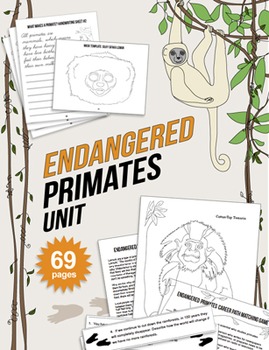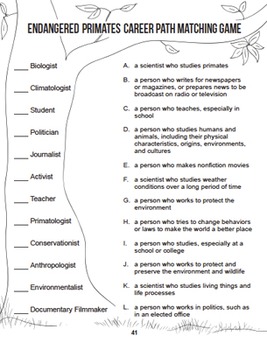Endangered Species Unit: Primate Lesson Plan
Kid World Citizen
3.8k Followers
Grade Levels
3rd - 6th, Homeschool
Subjects
Resource Type
Standards
CCSS4.NBT.A.1
CCSS4.NBT.A.3
CCSS4.OA.A.2
CCSS4.OA.A.3
CCSSRI.4.1
Formats Included
- PDF
Pages
69 pages
Kid World Citizen
3.8k Followers
Description
HUGE endangered species unit with science, readings, math, geography, masks, power points, take action posters, info chart, and more!
Through extensive interdisciplinary activities, students raise their awareness of environmental issues and what they can do to spread awareness about endangered species. Using science, balanced literacy, math, geography, art, oral and written communication skills, students learn about real world problems involving endangered species—and how to find creative solutions.
This unit includes 69 pages of common core-aligned activities and answer keys!
Included:
- Introduction to Endangered Primates Unit
- Common Core Standards
- Power Point Presentation to Introduce Unit
- 3 Separate Science Informational Reading Exercises: Roloway Monkey, Silky Sifaka, Cotton-Top Tamarin
- Info Grids to be Used with Readings
- Info Grids Answer Key
- Group Presentations on Readings
- Problem-to-Action Power Point Presentation
- Problem-to-Action Visual Organizer/Activity
- Problem-to-Action Activity Teacher's Guide
- Detailed Coloring Sheets on 3 Primates
- Take Action! Poster Activity
- Endangered Primate Mask Templates
- Alphabetical Order Activity with Key Science Terms
- Alphabetical Order Activity Answer Key
- Science Career Path Matching Game
- Science Career Path Matching Game Answer Key
- Endangered Species Word Problem Worksheet
- Word Problem Worksheet Answer Key
- Estimating Fun! Math Worksheets (Numerical and Word Problems related to endangered species)
- Estimating Fun! Answer Key
- Endangered Species/Environmental Journal Prompts Printable
- What Makes a Primate? Handwriting Sheets
- Endangered Animal WebQuest
- Mapping Endangered Primates Geography Activity
- Mapping Endangered Primates Geography Activity Answer Key
1) Students will be introduced to endangered species and 3 specific endangered primates with vocabulary and concepts in a power point
2) Students will read grade-level, non-fiction, scientific reading passages about one of the following endangered primates: Cotton-Topped Tamarin, Sifaka Lemur, Roloway Monkey. In groups, they will fill out a visual organizer "Info Grid" on their primate.
3) They will present their primate to the class; the class will fill in the Info Grid with information from the class presentations.
4) Students will participate in a Problem-to-Action activity with a power point and brainstorming worksheet focusing on deforestation and preventing extinction of endangered species.
5) Students will make masks of the 3 endangered primates in this unit, with adorable templates.
6) Students can color detailed coloring sheets of the 3 endangered primates in this unit to be used in their posters.
7) After learning about endangered species and discussing possible solutions, students make "Take Action" posters to spread awareness using the knowledge they've learned.
8) Students practice alphabetical using key scientific vocabulary from this unit.
9) In a matching activity, students use a dictionary to understand important science and environmental careers that work to protect endangered species.
10) Students solve math word problems related to endangered species.
11) Students practice estimating to solve multi-digit quotients and dividends, and then use this knowledge to solve word problems with estimating.
12) Students practice writing persuasive and narrative writing in endangered species-themed journal prompts.
13) Students learn more about characteristics common in primates through a series of handwriting practice sheets (cursive).
14) Students go on-line to complete a web quest about the endangered species of their choice.
15) Students use geography skills and follow directions on labeling a world map with key concepts, locations related to the endangered species in this unit, and other important information.
Endangered species is a theme often taught in elementary schools, and yet often times it is missing a fundamental idea: teaching kids that we are all connected! Our actions in one part of the world affect humans, animals, and plants around the world. By emphasizing this connection, the activities in the Kid World Citizen “Endangered Primates Unit” will have a lasting impact on students, empowering kids as they learn that they truly can make a positive difference in the world.
*****************************************************************************
Be the first to know about my new discounts, freebies and product launches:
Look for the green star next to my store logo and click it to become a follower. Voila! You will now receive email updates about this store. ☺
Through extensive interdisciplinary activities, students raise their awareness of environmental issues and what they can do to spread awareness about endangered species. Using science, balanced literacy, math, geography, art, oral and written communication skills, students learn about real world problems involving endangered species—and how to find creative solutions.
This unit includes 69 pages of common core-aligned activities and answer keys!
Included:
- Introduction to Endangered Primates Unit
- Common Core Standards
- Power Point Presentation to Introduce Unit
- 3 Separate Science Informational Reading Exercises: Roloway Monkey, Silky Sifaka, Cotton-Top Tamarin
- Info Grids to be Used with Readings
- Info Grids Answer Key
- Group Presentations on Readings
- Problem-to-Action Power Point Presentation
- Problem-to-Action Visual Organizer/Activity
- Problem-to-Action Activity Teacher's Guide
- Detailed Coloring Sheets on 3 Primates
- Take Action! Poster Activity
- Endangered Primate Mask Templates
- Alphabetical Order Activity with Key Science Terms
- Alphabetical Order Activity Answer Key
- Science Career Path Matching Game
- Science Career Path Matching Game Answer Key
- Endangered Species Word Problem Worksheet
- Word Problem Worksheet Answer Key
- Estimating Fun! Math Worksheets (Numerical and Word Problems related to endangered species)
- Estimating Fun! Answer Key
- Endangered Species/Environmental Journal Prompts Printable
- What Makes a Primate? Handwriting Sheets
- Endangered Animal WebQuest
- Mapping Endangered Primates Geography Activity
- Mapping Endangered Primates Geography Activity Answer Key
1) Students will be introduced to endangered species and 3 specific endangered primates with vocabulary and concepts in a power point
2) Students will read grade-level, non-fiction, scientific reading passages about one of the following endangered primates: Cotton-Topped Tamarin, Sifaka Lemur, Roloway Monkey. In groups, they will fill out a visual organizer "Info Grid" on their primate.
3) They will present their primate to the class; the class will fill in the Info Grid with information from the class presentations.
4) Students will participate in a Problem-to-Action activity with a power point and brainstorming worksheet focusing on deforestation and preventing extinction of endangered species.
5) Students will make masks of the 3 endangered primates in this unit, with adorable templates.
6) Students can color detailed coloring sheets of the 3 endangered primates in this unit to be used in their posters.
7) After learning about endangered species and discussing possible solutions, students make "Take Action" posters to spread awareness using the knowledge they've learned.
8) Students practice alphabetical using key scientific vocabulary from this unit.
9) In a matching activity, students use a dictionary to understand important science and environmental careers that work to protect endangered species.
10) Students solve math word problems related to endangered species.
11) Students practice estimating to solve multi-digit quotients and dividends, and then use this knowledge to solve word problems with estimating.
12) Students practice writing persuasive and narrative writing in endangered species-themed journal prompts.
13) Students learn more about characteristics common in primates through a series of handwriting practice sheets (cursive).
14) Students go on-line to complete a web quest about the endangered species of their choice.
15) Students use geography skills and follow directions on labeling a world map with key concepts, locations related to the endangered species in this unit, and other important information.
Endangered species is a theme often taught in elementary schools, and yet often times it is missing a fundamental idea: teaching kids that we are all connected! Our actions in one part of the world affect humans, animals, and plants around the world. By emphasizing this connection, the activities in the Kid World Citizen “Endangered Primates Unit” will have a lasting impact on students, empowering kids as they learn that they truly can make a positive difference in the world.
*****************************************************************************
Be the first to know about my new discounts, freebies and product launches:
Look for the green star next to my store logo and click it to become a follower. Voila! You will now receive email updates about this store. ☺
Total Pages
69 pages
Answer Key
Included
Teaching Duration
N/A
Last updated Jul 18th, 2014
Report this resource to TPT
Reported resources will be reviewed by our team. Report this resource to let us know if this resource violates TPT’s content guidelines.
Standards
to see state-specific standards (only available in the US).
CCSS4.NBT.A.1
Recognize that in a multi-digit whole number, a digit in one place represents ten times what it represents in the place to its right. For example, recognize that 700 ÷ 70 = 10 by applying concepts of place value and division.
CCSS4.NBT.A.3
Use place value understanding to round multi-digit whole numbers to any place.
CCSS4.OA.A.2
Multiply or divide to solve word problems involving multiplicative comparison, e.g., by using drawings and equations with a symbol for the unknown number to represent the problem, distinguishing multiplicative comparison from additive comparison.
CCSS4.OA.A.3
Solve multistep word problems posed with whole numbers and having whole-number answers using the four operations, including problems in which remainders must be interpreted. Represent these problems using equations with a letter standing for the unknown quantity. Assess the reasonableness of answers using mental computation and estimation strategies including rounding.
CCSSRI.4.1
Refer to details and examples in a text when explaining what the text says explicitly and when drawing inferences from the text.





